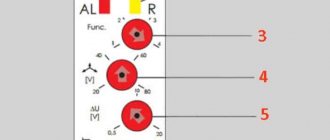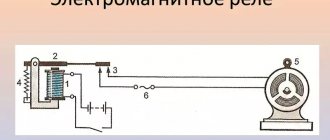| Parameter | Meaning |
| Operating measured voltage, V | ~50-400, 50 (+/-1) Hz |
| In active load, A | 50 |
| Imax active load, A | 60 |
| Rated power Pnom, W | 10000 |
| Maximum power Pnom, W | 12500 |
| Adjustable lower value Ulow shutdown, V | 120-200 (170) |
| Adjustable upper value Uup shutdown, V | 210-270 (250) |
| Shutdown time according to Umax (upper limit), no more, sec | 0,04 |
| Shutdown time according to Umin (lower limit), no more, sec | 0.06 (<120 V) / 1 (120-200 V) |
| Shutdown time, sec when In is exceeded | 600 |
| Shutdown time, sec when Imax is exceeded | 0,04 |
| Adjustable turn-on delay time (voltage protection), sec | 5-600 |
| Default turn-on delay time (factory setting), sec | 15 |
| Switching on after current protection has tripped | forcibly |
| Current protection shutdown function | There is |
| Calibration of instrument readings | There is |
| Voltage measurement error, % no more | 1 |
| Current measurement error, % no more | 1 |
| Case size, 17.5 mm modules | 3 |
| Operating temperature, C° | -25…+50 |
| Device protection degree | IP20 |
Voltage relay connection diagram
Let me show you once again what the connection of a voltage relay in an electrical panel looks like:
Voltage relay installed in the electrical panel. Voltage 220V.
The photo shows a Digitop voltage relay, as a review I can say that I connected these several times, there were no problems.
The voltage relay must be protected by an input circuit breaker. The machine can be placed before or after the counter, but it must be there in any case. The rating of the machine is one step less than the rated current of the voltage relay. In the above case, this rule does not apply:
Automatic machines, counter, voltage relay
In justification, I can say that in voltage relays they usually put a relay one step larger. I discovered the Ukrainian Barrier and Digitop, for example, with a nominal value of 32 A, the voltage relay circuit contains a 40 A relay, which is very commendable.
Setting up the voltage relay with current control VA-50 DigiTOP
The high and low voltage protective shutdown parameters are located in the device’s non-volatile memory and can be changed by the user in accordance with the required need. The protective current shutdown is hard-coded in the device’s memory and corresponds to its rating. For the VA-protector series: VA-32, VA-40, VA-50 and VA-63 are 32, 40, 50, and 63 amperes, respectively. For VA-50 DigiTOP – nominal programmed value 50A, maximum 60A. The current control function can be disabled by the user if desired.
Operating parameters are configured using the controls and indications of the device itself. These include two digital indicators and three control buttons, which are located on its front part. The indicators are located on the left and display the following values:
The upper indicator is indicated by the symbol “V” and displays:
- — V – value of the current voltage level in the network (in operating mode)
- — V – response level based on the lower value of U (by pressing the “ᴠ” sign once)
- — V – triggering level based on the upper value of U (by pressing the “ᴧ” sign once)
- — V – settable shutdown limit level at the top or bottom (when setting and changing response parameters, long press on the “ᴧ” or “ᴠ” signs, respectively)
- — V – delay time when turned on (by pressing the signs “ᴧ” and “ᴠ” simultaneously)
The lower indicator is indicated by the symbol “A” and displays:
- — A – current load level in amperes (in operating mode)
- — A – operating mode of the current limiting function — “On” or “OFF” (in setup mode, when you press the “start” sign once)
- — A – running line “OVERLOAD” (if the power limiter has tripped).
The control buttons are located to the right of the indicators, located under the signs “ᴧ” and “ᴠ”, in a circle, and are used for: - pressing "ᴧ" to set the maximum allowed value, B - pressing "ᴠ" to set the minimum allowed value, B - pressing both signs “ᴧ” and “ᴠ” to change the turn-on delay time, s - “start” icon to turn the power limit on or off - “On” or “OFF” - “start” icon to restart the device if the power limiter is triggered .
Voltage relay connection
How to connect the voltage relay is shown in the diagram below:
Voltage relay connection diagram
This is a standard scheme. Thick lines show power circuits.
If you are on the safe side, it is better to use an automatic bypass in the connection diagram (not shown in the diagram, but is in the photo above), as is done in voltage stabilizers. This is done so that the consumer can at least work if the voltage goes beyond the limits. If necessary.
The bypass machine is connected parallel to the internal relay contacts of our voltage relay. If we take the connection diagram given above, then this is between pins 2 and 3.
A bypass can also be useful if the voltage relay itself fails.
Types of launch vehicles
Various types of devices need protection from voltage surges. Some of them operate on household voltage 220 V and consume minimal power. Examples of such devices include smartphone chargers or LED light bulbs. Others also operate on 220 V, but already consume thousands of watts of power, for example, electric kettles and irons. Still other devices require three-phase power supply of 380 V. A conventional single-pole LV is not suitable for them. Among such consumers are industrial machines and powerful asynchronous motors. Therefore, all relays for voltage control are usually divided by type of housing and type of load.
By case type
This classification indicates which devices and in what quantities can be connected to the relay. According to the type of execution, the launch vehicle is divided into 3 types:
- rosette;
- in the form of an extension;
- with installation on DIN rail.
The first type is the easiest to use. This surge protection relay plugs directly into an outlet. On one side of the case there is a corresponding connector in the form of a plug. On the other part of the device there is a standard socket for connecting the load. This type of LV can be quickly removed and connected to another location.
The second type is made in the form of an extension cord. On its surface there are several sockets for loading. Unlike type 1, this relay is equipped with a cable and plug. The device is convenient for stationary connection of office equipment.
The third type is the most professional. The pH is installed in the shield. It has an extended list of functions, high throughput, and at the same time protects all electrical appliances in the apartment.
By number of phases
Electrical consumers operating on alternating current are divided into 2 groups. The voltage control relay has a similar division. Namely:
- single-phase LV;
- three-phase.
Single-phase modification is suitable for home use. These relays are installed in apartments, garages and cottages. They pass through one phase and zero. That's why they are called single-phase.
The operating voltage for such LVs is 220V. Their contacts are designed for a current of 30-40 A, which corresponds to the maximum values for residential wiring. The device has a minimal list of settings and, if you read the instructions, is suitable for use by an ordinary person without specialized education.
Three-phase voltage monitoring relay ZUBR 3F
The second type of relay is more complicated. It controls voltage on 3 phases simultaneously. This modification is suitable for units consuming 380 V from a network. The relay has an expanded list of adjustments and requires minimal experience in setting up automation systems.
Voltage relay for powerful consumers
If the consumer current is more than 63A, and frequent operations are expected, then it is better and more reliable to use an additional starter. I have already written about choosing a starter (or contactor).
By the way, if you are at all interested in what I write about, subscribe to receive new articles and join the group on VK!
In this case, the contacts of the voltage relay (16 or 20A) turn on the starter coil, and the starter with its contacts can already turn on a load of tens of kilowatts, if necessary.
general description
Voltage relay with current control VA-63 is the most powerful device in the VA-protector series, which successfully combines the functions of such devices as a voltmeter, ammeter, current and voltage protection in one housing. With a large number of functions, it has small dimensions and sufficient power reserve for use, without the use of additional switching elements. The rated load through the VA-63 voltage relay is up to 13.8 kW, which corresponds to a current of 63 amperes. Ideal for a country house, cottage or large apartment with a full set of household appliances.
Which is better: relay or stabilizer
Some users use a standard voltage stabilizer in their home instead of a control relay. In some cases, such a decision is considered justified. However, several nuances have been noted that are taken into account when choosing a reliable method of protecting electrical appliances. First of all, you need to keep in mind that they perform similar functions and can turn off the load in an emergency. But there is still a difference in their work and is manifested in the following:
- stabilizers are characterized by an increased noise level and are much more expensive;
- they are more inertial, especially when monitoring sudden voltage changes;
- they do not provide the ability to adjust setting parameters;
- These devices take up significantly more space.
As the input signal decreases, the stabilizer begins to consume more current, which is explained by the need to maintain the output voltage at a constant level.
The main disadvantage of the stabilizer in comparison with the RKN is the inability to respond to sudden voltage drops in the network when the neutral wire breaks.
Just a fraction of a second is enough for a voltage surge of 350–380 volts to burn out all household appliances connected to the outlets. Most of the electronic stabilizer samples produced by the domestic industry are not capable of responding to short-term pulsations. The characteristics of stationary devices provide for a reaction time not exceeding 1-2 seconds. Therefore, the correct approach to choosing a protection device guarantees the safety of the equipment connected to it.
Selection criteria and alternatives
A more advanced device, so to speak, the oldest model in the line of overvoltage and overload protection, is only the MP-63A multifunctional relay, which has three indicators for monitoring and configuration, as well as an extended menu through which you can also change such a parameter as the cutoff current. In addition, the delay time for automatic switching on when the current protection is triggered is also programmed. This feature makes the MP-63A multifunctional relay more versatile when customized to the current needs of the client at a given time.
If the planned maximum consumption is determined to be at least 8 kW (40A) - you can buy a voltage relay with current control VA-63 - this will be your best choice with the ability to easily increase the number of household appliances in the future if necessary. The entire range of parameters necessary for the user is convenient to control and configure due to the presence of two separate indicators. A convenient menu, if necessary, will allow an ordinary user who does not have special skills to change the factory settings of the trigger levels and the delay time for subsequent automatic activation.
Varieties of RLVs according to other parameters
In addition to differences in the type of power supply, these devices differ in a number of characteristics that determine the method of their installation, and in functionality.
Type of execution and dimensions
In accordance with this feature, all RLV models produced by industry are divided into three types:
- plug-socket adapters;
- extension cords with several sockets (from one to six);
- compact switches mounted on a DIN rail in a panel.
Single-phase voltage relay RN-111M 1F NOVATEK
Voltage relay with plug and socket
The first two product options are used to protect individual electrical appliances or several consumers combined into groups. They connect to a regular power outlet. Devices of the third type are installed in an electrical panel in which other protection devices are mounted.
Adapter housings and extension cords are made quite convenient to use. Manufacturers try to reduce their dimensions as much as possible so that they do not spoil the interiors with their appearance.
DIN rail-mounted devices are more compact in size because they do not require additional accessories to be installed. Wires are connected to them in the same way as is done when installing conventional automatic machines or RCDs.
Base and additional functions
According to the internal logic of operation and electronic filling, all known RKN samples are divided into microprocessor products and devices made on the basis of digital comparators. The first of them are somewhat more expensive, but they provide more accurate and smooth adjustment of the lower and upper response thresholds. Most of these protective devices are microprocessor based and stand out from other products due to the following features:
- the presence of two response thresholds (Umax and Umin);
- the use of built-in LEDs mounted in the device panel - they monitor the presence of voltage at the input and output;
- the use of a liquid crystal display, which displays the values of permissible deviation limits and effective voltage.
All these features significantly increase the functionality of the devices and simplify working with them when installed in an apartment or private house.










